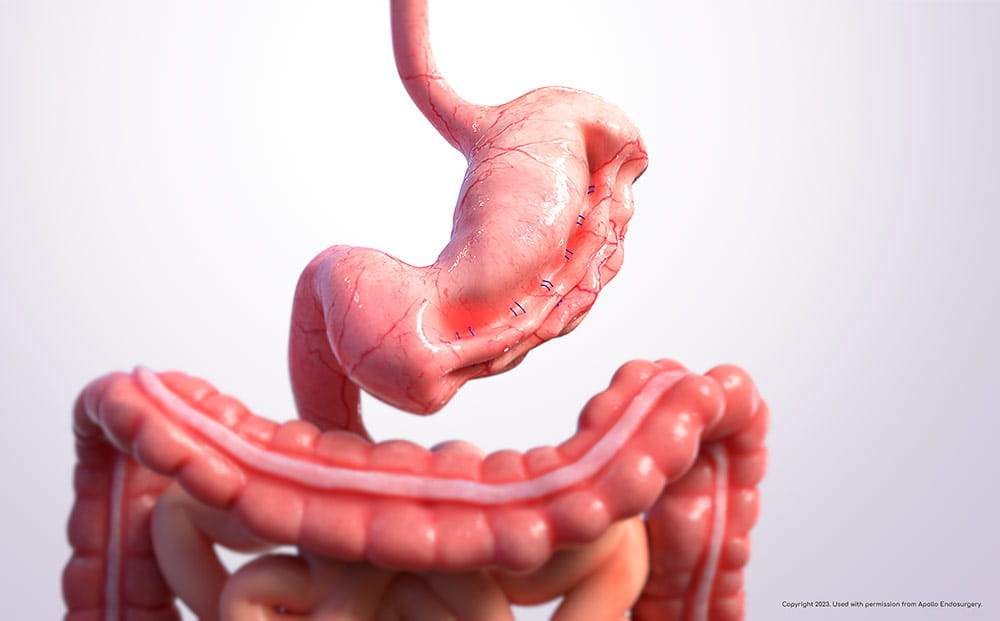Endoscopic Sleeve Gastroplasty (ESG)
One of the most effective endoscopic weight loss procedures available, ESG may be an option for patients who have tried to lose weight through diet and exercise but have been unsuccessful at achieving and maintaining the desired results.
The procedure reduces stomach size by 60-70 percent which limits the amount of food it can hold and creates a feeling of fullness after eating much less. When combined with a healthy lifestyle and medical supervision, ESG can result in relatively rapid, sustainable weight loss.
Who is Eligible for Endoscopic Sleeve Gastroplasty?

ESG may be an option for patients who prefer not to undergo traditional surgery or are ineligible for more invasive procedures for medical reasons. Additional criteria include:
- A body mass index (BMI) of at least 30
- At least 21 years of age
- Previous weight loss efforts have been unsuccessful
- Willing to commit to lifestyle changes
Preparing for ESG
Before scheduling your procedure, your weight loss surgeon will conduct a physical exam and take a complete medical history. You will be asked about your previous weight loss efforts, medical conditions you have and any medications you are taking – you may be asked to stop or change certain medications before and after the procedure. Certain lab tests may also be ordered.
For your safety, it is important to follow your healthcare provider’s instructions exactly, including when to start fasting – typically at least 8-12 hours before your procedure.
The Day of the Procedure
ESG is performed under general anesthesia and generally takes 60-90 minutes to complete.
Once you are asleep, the surgeon will insert a flexible tube (endoscope) equipped with a camera and a special suturing system through your mouth, down your throat and into your stomach. Approximately 6-8 stitches will be placed in the stomach to reduce its size and change its shape to resemble a tube or sleeve. The stitches will be tightened until the desired stomach size and shape is achieved.
Once the stitching is complete, the surgeon withdraws the endoscope and you will be moved to a post-anesthesia care unit (UNIT) for observation until you have fully woken up. There are no external incisions and most people go home the same day or the day after the procedure. For safety reasons, patients must make arrangements for a friend or family member to drive them home.
Recovering after Endoscopic Sleeve Gastroplasty
Benefits of ESG for Weight Loss
Studies have shown that, on average, patients who have undergone ESG lose 49 percent of excess body weight and 14 percent of total body weight at 12 months post-procedure. In addition to weight loss, many patients show measureable improvement in weight-related medical conditions like diabetes, hypertension, high cholesterol, sleep apnea and joint pain. Additional benefits include:
- No external incisions or scars
- Fast recovery with minimal downtime
- Very low risk of complications
- Improved confidence and more energy
In addition, ESG is a reversible procedure and can be converted to other, more traditional bariatric procedures in the future, if needed.
Patients may experience mild to moderate abdominal pain and nausea for the first few days after discharge. Your weight loss surgeon can provide medications to help manage these symptoms.
Otherwise, recovery time is usually relatively fast with most patients returning to work and/or regular activities after just a few days. As time goes by, the stomach tissue heals around the stitches and the new shape of your stomach becomes more permanent. However, the stitches do not dissolve and can be removed later if the procedure needs to be reversed.
Your care team will provide detailed instructions related to dietary restrictions in the first few weeks after the procedure. As you adjust to your smaller stomach, most people will be advised to gradually transition from clear liquids only, to liquids with protein powder, to soft foods. Solid foods are usually reintroduced at about one month post-procedure. To ensure adequate nutrition, your diet should emphasize only healthy nutrient-dense foods since you will not be able to eat as much.
Follow-up care will include regular appointments with your doctor and consultations with a dietitian to monitor your progress and ensure your nutritional needs are being met.
Insurance
Endoscopic sleeve gastroplasty may not be covered by all insurance providers. University Hospitals offers self-pay or finance options if your insurance does not cover this procedure.


